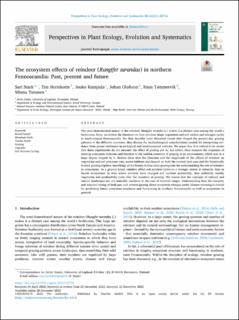The ecosystem effects of reindeer (Rangifer tarandus) in northern Fennoscandia: Past, present and future
Peer reviewed, Journal article
Published version

Åpne
Permanent lenke
https://hdl.handle.net/11250/3040456Utgivelsesdato
2022Metadata
Vis full innførselSamlinger
- Publikasjoner fra CRIStin - NINA [2364]
- Scientific publications [1392]
Originalversjon
10.1016/j.ppees.2022.125716Sammendrag
The semi-domesticated nature of the reindeer (Rangifer tarandus L.) makes it a distinct case among the world’s herbivores. Here, we review the literature on how reindeer shape vegetation and soil carbon and nitrogen cycles in northernmost Fennoscandia. We first describe main historical events that shaped the present-day grazing patterns in the different countries, then discuss the methodological considerations needed for interpreting evidence from grazer exclosures in ecological and environmental contexts. We argue that it is critical to be aware that these experiments do not measure the effect of grazing per se, but rather, they measure the responses of existing ecosystem structure and function to the sudden cessation of grazing in an environment, which was to a large degree shaped by it. Studies show that the direction and the magnitude of the effects of reindeer on vegetation and soil processes vary across habitats and depend on both the current land-uses and the historically formed grazing regimes; knowledge of the history is thus a key prerequisite for understanding the role of reindeer in ecosystems. As a general trend, reindeer affect soil nutrient cycles to a stronger extent in subarctic than in boreal ecosystems. In sites where reindeer have changed soil nutrient availability, they indirectly modify vegetation and productivity even after the cessation of grazing. We reason that the concepts of cultural and natural landscapes are not mutually exclusive in the case of reindeer ranges. Understanding how the intensity and seasonal timing of both past and present grazing direct ecosystem changes under climate warming is crucial for predicting future ecosystem structures and functioning in northern Fennoscandia as well as ecosystems in general. Boreal forests, Mountain birch, Tundra heath, Grazing, Ungulate, Soil Nutrient Cycling
